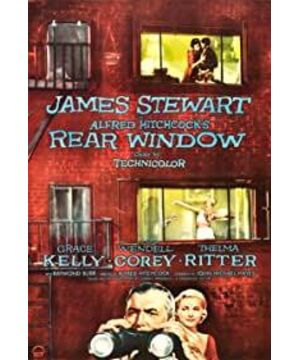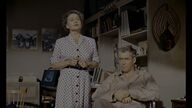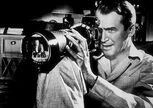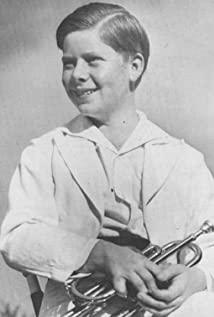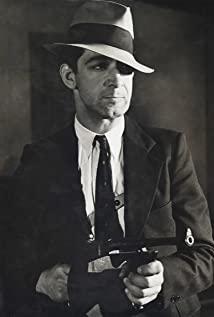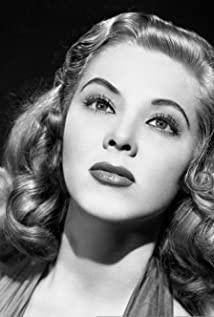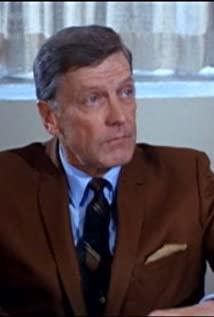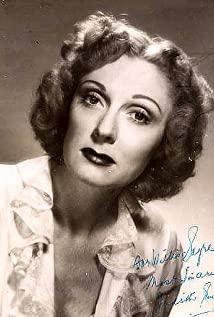Of course, "I" would not be so cute. How could the murderer who killed his wife and corpse be cute? But the first concern here is not appearance and appearance, but why Hitchcock wants Stewart to "look from the opposite side" instead of arranging his room on a safer top floor? Although the protagonist turns off the light or retracts the wheelchair to avoid being discovered in the movie, the effectiveness of this concealment behavior is seriously questioned considering the actual height of the room. In other words, under the conditions at the time, the probability of his voyeurism being undetected was very low! What's more, there is also a highly nervous and sensitive murderer among those people.
I secretly thought that Hitchcock, who has always regarded the audience as the core of his creation, would not fail to take this into consideration. Therefore, the height of the floor that easily reveals the identity may be set for a purpose that is more important than reality. This purpose should be the expressiveness of subjective perspective. There are seven households on the opposite side. The depressed old maiden who lives on the right hand side of the first floor is a key role. Stewart's shots (that is, the eyes of the audience) need to constantly pay attention to the changes in her mood and behavior in order to provide a reasonable pavement for the subsequent development of the plot. Assuming that the protagonist’s floor is placed on the top floor, the camera needs to be tilted at a greater angle to be able to look down. And this will inevitably cause the protagonist to not see (or look at it very hard) the situation of the woman in the room. He can't see it, which means that the audience who merges with his perspective can't see it. In this regard, Hitchcock is of course unacceptable. Therefore, he must adjust the floor to a height that is more suitable and capable of "taking care" of all aspects.
Now that the locations of each house are properly placed, the protagonist will start to look at it. He looked left and right and looked up and down, and it turned out that every tenant was not easy. A charming dancer is wearing a bra and shorts and doing housework with graceful dance steps every day; a composer who lives alone often sits at the piano and writes, and is no exception when doing housework; a childless couple is very hot Lying on the balcony on the third floor to cool off, put the puppy down to play every day; the wife of Mr. Su, a salesman on the second floor, was bedridden for a long time, and two people's corners could be seen from time to time; the single woman on the first floor seemed to always be unable to find a partner, Jie Jie Fury called "Lonely Heart"; a newlywed couple moved into the apartment busy and intimacy, then put down the curtains, and then rarely appeared... (The above guest introduction part is a lazy excerpt from the plot introduction of the film on this website) Finally He locked the strange man who went out with suitcases three times in the rainy night!
In many interviews, Hitchcock often uses the peeping passages of Stewart in the film as an example to explain what Pure Cinema he admires. In fact, this concept of montage is not new. It was proposed by Pudovkin and others in the Soviet Union more than 20 years before the film was produced. But Hitchcock took it to the extreme. "Rear Window" has therefore had a profound impact on many younger directors. Among them is Bogdanovic. The commendable thing is that Bogdanovic did not simply imitate, but developed and enriched after learning. In "Rear Window", the camera shows Stewart watching, then what he is watching, and finally switching back to show his reaction after watching. The emphasis is more on a state of mind. And in "Paper Moon", a little girl helps the hero to sell the Bible. The two knocked on the door of their house, and the camera first showed the little girl looking sideways into the house. Then cut into the house to display its decorative furniture-either simple or luxurious. Finally cut back to the little girl. At this time, her reaction was not expressions, but behaviors: when the house in her home was simple, she lowered the price of the book; when it was luxurious, she raised it. This is what Hitchcock called Pure Cinema. The effect is difficult to convey in literature. Imagine how to describe a girl's "seeing people and eating dishes" in a novel? It seems more difficult. Because when you use words to describe the details of the room, you have deprived the audience of imagination. They don't have the kind of knowing smiles they have when watching a movie.
The protagonist finds the suspect, but the police in the film are as slow and stubborn as ever. So the three had no choice but to act as a cameo detective to investigate. At this climax of the investigation where the suspense continues to accumulate and release, the narrative effect of the tenants who spent much space in the front begins to appear. Yes, that is the "lonely heart"! When Kelly broke into the house, the poor woman was about to commit suicide! So the sympathetic protagonist turned his attention completely to her, but forgot to remind Kelly that the murderer, who was still rummaging in the house, was hurried back to the house. At the critical moment, the "just right" care for one and the other caused the audience to have a strong sense of anxiety about the heroine: she won't catch it, will she? Then, just as the last wave of tension was about to be relieved due to the police's arrival in time, another wave of horror abruptly: the telephoto lens that locked his girlfriend was moved and lifted to the right. The picture is a close-up of the murderer. At this moment, he just noticed that Kelly was tying a signal, and raised his head in the direction of the gesture and looked straight over! The fierce light gleaming behind the lens couldn't help making the audience and the protagonist take a breath at the same time. Hitchcock cleverly used the theme-related voyeuristic tool's "picture zoom in, space shrink" feature to create the most horrifying moment in the film. Just imagine, if the above shots are performed through Stewart's ordinary point of view, the process of being discovered by the murderer is done in a relatively far away panorama. The horror effect will be greatly reduced. But Hitchcock's talent for using the environment, character, and professional characteristics is not satisfactory in another classic paragraph. After discovering the truth, the murderer came upstairs to find him to settle accounts. In a hurry, he dazzled the murderer's eyes with a flashlight several times. The screen full of red gradual retreat represents the murderer's recovery from a short-term blindness. Although the visual effect is good, the technique is obviously distorted due to the excessive pursuit of stylization. Because even though the protagonist was really inconvenient at the time, he wouldn't be overwhelmed to use the flash to defend himself, right?
Hitchcock likes to create "spectacles" with strong contrast effects to highlight the existence of bad guys. The only drummer in the band "Young Girls" with trembling eyelids is the murderer; and the only one in "The Train Strangers" whose head does not move rhythmically with the tennis ball but stares at Hines is The perverted Bruno who killed his wife for him. This film is naturally indispensable for such a classic lens. When the woman on the third floor discovered that the puppy had died tragically and went to the balcony to cry loudly, the lights in all the windows were on, and the neighbors stood up to check. The only window is always dark. It's just that the cigarette butts are faintly flashing...
After the storm, the fate of neighbors is different. Anyone who opens the skylight so that the hero can see through has a happy ending: the sister of the devil figure finds true love (although the other is a short rub); the pianist finds inspiration, and the suicide girl is reborn; tragic death My puppy’s parents have new pets. And in turn, Hitchcock's relentless "retaliation" for the two homes that prevented him from peeping smoothly. Murderers belong to the standard "death". And the newlyweds seemed to be on the verge of breaking their homes. Of course, this way of dealing with the prosperity of those who follow me and the death of those who oppose me does not have to rise to the height of morality or the dark side for interpretation. It is nothing but the black humor that Hitchcock loves.
And similar black humor also appears on the protagonist. Stewart, who had fallen asleep sweetly in the warm sun, had both legs in casts. Kelly, who changed his outfit next to him, reclined on the recliner and flipped through the magazine leisurely. A murderous corpse has achieved a wonderful marriage. Regarding the plaster, a film critic once pointed out that the male protagonist played by Stewart in this film has a metaphor of male incompetence that is common in Hitchcock movies. And the thick plaster on his leg is a metaphor for not lifting. Personally don't agree with this view. Because it cannot explain why the plaster changed from one to two? Could it be that Hitchcock was using this to express: Stewart was relieved after being completely incompetent. Can he finally start a long-awaited platonic relationship with Kelly? Kelly, who was then panned by the camera, further confirmed: Well, that's right, it's like this. Why should I change into long pants? ...
View more about Rear Window reviews


